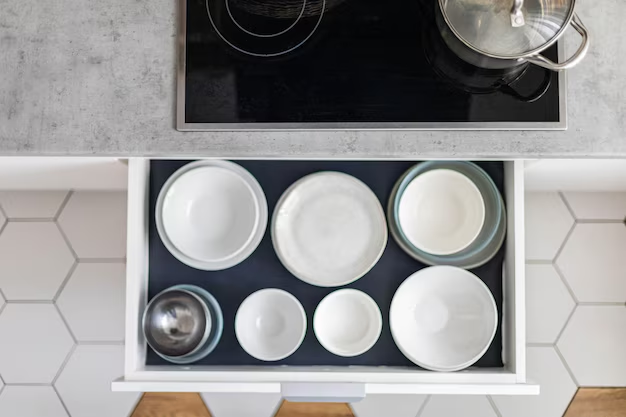Creating the Perfect Space for Your Refrigerator: A Comprehensive Guide
Refrigerators are an indispensable part of modern kitchens, cooling our produce and preserving perishables. Despite their reliability, they often pose a significant question during kitchen remodels or installations: How much space should you leave around your refrigerator? This isn’t just a matter of fitting the appliance into an available nook; it’s about ensuring optimal performance, ease of use, and the longevity of your fridge. In this guide, we'll explore the reasons behind spacing recommendations, practical insights for different fridge types, and tips to enhance both function and aesthetics in your kitchen.
📏 Why Space Matters Around Your Refrigerator
Ventilation and Efficiency
Refrigerators need proper ventilation to function efficiently. Restricted airflow can cause the compressor to overwork, leading to higher energy bills and potential breakdowns. Adequate spacing ensures that the heat generated by the appliance dissipates effectively, maintaining its efficiency and extending its lifespan.
Ease of Use
Ample space around your refrigerator is vital for comfort and accessibility. It allows for full door opening, preventing cramped and inconvenient maneuvering when accessing the contents. Consideration of space also enables smooth movement, avoiding potential hazards or injuries.
Aesthetic Appeal
A well-placed refrigerator contributes to the kitchen’s visual harmony. Sufficient spacing ensures the appliance fits seamlessly with cabinetry and other fittings, preventing a cluttered appearance and enhancing the overall aesthetic of the kitchen.
Safety Concerns
Proper spacing helps avoid overheating and fire risks. By allowing your refrigerator to breathe, you mitigate the dangers associated with heat buildup, ensuring the safety of your kitchen and home.
⏳ Understanding Recommended Refrigerator Spaces
H2: Key Dimensions to Consider
Side Clearance
Even a small fridge unit often requires at least an inch of space on either side. This clearance is crucial for minimizing operational noise and enhancing heat dispersion.Top Clearance
A top clearance of 1-2 inches is commonly recommended. It allows warm air to escape, preventing heat buildup that can overwork your refrigerator.Rear Clearance
Refrigerators ideally require 2 inches of space behind them. This ensures that the coils and other back components have proper airflow.Front Clearance
Though often overlooked, frontal clearance is vital. Having a minimum of 48 inches of space in front of your fridge allows for safe movement and full door swing.
H3: Appliance Type and Space Considerations
Freestanding Refrigerators
These units need more clearance compared to built-in models. Generally, ½–1 inch on the sides, 1 inch at the top, and 2 inches at the back are recommended to permit adequate airflow and heat management.
Built-in Refrigerators
Designed to fit snugly within cabinetry, these often require less clearance for sides and top, sometimes as little as ¼ inch. However, rear spacing is crucial to avoid overheating.
Side-by-Side Refrigerators
The design allows for a narrower door swing, making them suitable for tighter spaces, but proper side clearance remains important for airflow.
French Door Refrigerators
These combine the accessibility of a bottom freezer with the reduced door swing of side-by-sides, though they still require ample space at the back and sides to operate efficiently.
🏡 Practical Tips for Optimal Refrigerator Placement
Measure Twice, Place Once
Always measure the space available before purchasing a refrigerator. Take into account the need for doors to open fully without obstruction from adjacent walls or cabinets.
Consider Built-In Options
For kitchens where space is at a premium, a built-in refrigerator can be an excellent choice. They often require less clearance and integrate seamlessly with cabinetry.
Install Adjustable Shelves
These can help cope with vertical space constraints, especially if additional clearance at the top isn’t feasible due to existing cabinets.
Maximize Kitchen Layout
Ensure there’s a direct route between your refrigerator, sink, and stove for efficient workflow and accessibility.
Regular Cleaning and Maintenance
Keeping the area around the refrigerator dust-free improves air quality and performance. Routine checks and cleaning can extend the lifespan of your unit.
🔄 Balancing Functionality and Design
The ideal refrigerator placement balances function with style. Here are several ways to achieve both:
Integrated Cabinetry
Custom cabinetry that matches the refrigerator size can enhance visual appeal while subtly maintaining necessary clearances.Kitchen Islands
When layout allows, position a refrigerator so its doors face the kitchen island. This setup ensures easy access during cooking or social events.Fridge Overlays
Replaceable panel fronts can disguise a refrigerator to mesh with your kitchen’s design without affecting the necessary airflow.
🌟 Simplified Summary: Refrigerator Space Rules
Below is a concise summary of the refrigerator spacing guidelines to remember, ensuring efficient and safe appliance operation:
- Side Clearance: ½–1 inch for airflow
- Top Clearance: 1–2 inches helps heat dissipation
- Rear Clearance: At least 2 inches prevents overheating
- Front Clearance: Minimum of 48 inches for full accessibility
- Cleaning: Routine cleaning ensures optimal performance
🤝 Bringing it All Together
Crafting the perfect kitchen space for your refrigerator requires thoughtful consideration of several factors. By ensuring adequate spacing, you enhance your appliance's efficiency, safety, and longevity while maintaining harmony in your kitchen's design. Whether you’re upgrading an old appliance or installing a new one, this comprehensive guide will help you make informed decisions, ensuring your refrigerator stands as both a functional and stylish centerpiece in your kitchen.
